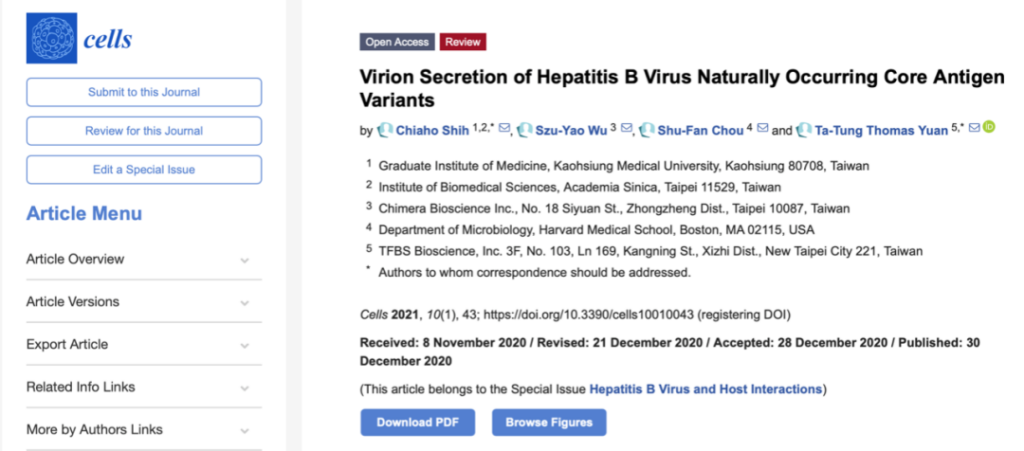Hepatitis B drugs: HBV secretion may be a new target
- A Single US$2.15-Million Injection to Block 90% of Cancer Cell Formation
- WIV: Prevention of New Disease X and Investigation of the Origin of COVID-19
- Why Botulinum Toxin Reigns as One of the Deadliest Poisons?
- FDA Approves Pfizer’s One-Time Gene Therapy for Hemophilia B: $3.5 Million per Dose
- Aspirin: Study Finds Greater Benefits for These Colorectal Cancer Patients
- Cancer Can Occur Without Genetic Mutations?
Hepatitis B drugs: HBV secretion may be a new target
Hepatitis B drugs: HBV secretion may be a new target. At the end of last year, researchers from the Institute of Medicine, Kaohsiung Medical University, Taiwan, China, introduced that the most common core protein (HBc) mutation in patients with chronic hepatitis B is the mutant strain 97L, which changes from isoleucine or phenylalanine at amino acid 97 of HBc. It is leucine (L).
According to the researchers, experiments in mice confirmed that the persistence of HBV DNA in the liver is related to virus secretion regulated by the maturity of the HBV genome. Researchers believe that hepatitis B virus secretion may be the target of antiviral drugs.

Hepatitis B drug discovery, researchers reveal that HBV secretion may be a new target
In the Cells magazine on December 30, 2020, researchers from the Institute of Medicine of Kaohsiung Medical University, Taiwan, China, the Institute of Biomedicine, Academia Sinica, Chimera Bioscience, and the Department of Microbiology, Harvard Medical School, Boston, Massachusetts, USA, jointly completed and published The above conclusion. The researchers said that one direction in the field of hepatitis B virus research is that wild-type HBV mainly secretes virus particles containing mature double-stranded DNA genomes. The immature genome, which contains single-stranded RNA or DNA, cannot be effectively secreted until the genome reaches maturity.
Interestingly, HBc variant 97L does not follow this principle in the secretion of hepatitis B virus particles. Instead, it exhibits an immature secretion phenotype, preferentially secreting virus particles containing immature genomes. In different naturally-occurring HBc variants, other abnormal behaviors of virus particle secretion have also been observed. The morphogenesis of viral particles must involve the interaction between HBc, envelope protein (HBsAg) and host factors, such as the components of the endosomal classification complex required for transport.

Immature secretion can be offset by compensatory mutations, which occur in other parts of HBc or HBsAg. Based on the above findings, the researchers concluded that the secretion of hepatitis B virus may be the target for the development of antiviral drugs. The researchers dissected this immature secretory phenotype mutant strain 97L through a variety of methods, including cis-trans gene complementation experiments and hydrodynamic administration mouse model experiments. The results showed that compensatory mutations in the core or envelope of HBV can eliminate the immature secretion of mutant 97L.
In the kinetic analysis of virus secretion in the time course experiment, wild-type HBV and mutant strain 97L showed no significant difference in the release of immature or mature genomes. When the researchers used the hydrodynamic mouse model to study, they observed a rapid decline in the HBVDNA of the mutant I 97L, and the correlation between the persistence of the HBVDNA of the mutant P130T in vivo and the overmaturity of the genome. The researchers asked, can the results obtained on mice be extended to human patients?
As we all know, serum HBV-DNA level is the main predictor of hepatitis B surface antigen, HBV-DNA and hepatitis B surface antigen spontaneous serum clearance. Therefore, in longitudinal follow-up studies, it is reasonable to predict that chronic carriers with HBC97L mutations will have a higher spontaneous clearance rate. In fact, in a small cohort study of patients with chronic hepatitis B, the core mutation 97L seemed to help predict persistently low levels of HBV DNA, normal ALT and HBsAg clearance.
Quantitative monitoring of hepatitis B surface antigen in the late stage of chronic infection can help medical scientists in the field of liver disease around the world better understand and manage chronic hepatitis B e antigen-negative carriers. Researchers believe that it is easy to speculate here that the mutation I97L may be used in combination with hepatitis B surface antigen quantitatively to obtain a higher predictive ability of functional cure (loss of hepatitis B surface antigen). In addition, although NUC treatment can suppress serum HBV-DNA to an undetectable level, a lifelong NUC treatment is required to prevent HBV recurrence.
Therefore, the researchers said, it will be an interesting question to compare the curative effect of NUC treatment with or without I97L or P130T mutations in chronic e antigen-negative patients with limited or indefinite life. Another question to be solved is whether the immature virus particles of these mutant strains of 97L are infectious through in vivo or in vitro infection experiments. The virus particles secreted by the mutant strain 97L contain almost equal numbers of mature and immature genomes. By density gradient ultracentrifugation, we cannot separate immature virus from mature virus.
Xiaofan Health Conclusion: Generally speaking, on December 30, 2020, at Cells, researchers from the Institute of Medicine, Kaohsiung Medical University, Taiwan, China, introduced that these HBV mutations provide a useful research tool for studying the mechanism of virus release. And in the near future can be used as a target for drug discovery. The mutant strain 97L is also likely to predict the NUC treatment effect or the spontaneous clearance rate of serum HBVDNA and HBsAg in patients with chronic hepatitis B (Researchers: Chiaho Shih, Szu Yao Wu, Shu Fan Chou, Ta Tung Thomas Yuan)
(sourcesohu, reference only)
Disclaimer of medicaltrend.org



